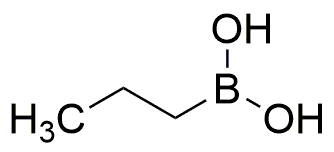Propylboronic acid is widely utilized in research focused on:
- Organic Synthesis: It serves as a crucial building block in the synthesis of various organic compounds, particularly in the formation of carbon-carbon bonds through Suzuki coupling reactions, which are essential in creating pharmaceuticals and agrochemicals.
- Drug Development: Researchers leverage its properties to develop new drug candidates, particularly in the design of boron-containing compounds that can enhance the efficacy of therapeutic agents.
- Material Science: It is used in the development of advanced materials, including polymers and nanomaterials, due to its ability to modify material properties and improve performance in applications such as sensors and catalysts.
- Bioconjugation: Propylboronic acid is applied in bioconjugation techniques, facilitating the attachment of biomolecules to surfaces or other molecules, which is vital in creating targeted drug delivery systems.
- Analytical Chemistry: It plays a role in analytical methods, particularly in the detection and quantification of certain biomolecules, enhancing the sensitivity and specificity of assays used in clinical and environmental testing.
General Information
Properties
Safety and Regulations
Applications
Propylboronic acid is widely utilized in research focused on:
- Organic Synthesis: It serves as a crucial building block in the synthesis of various organic compounds, particularly in the formation of carbon-carbon bonds through Suzuki coupling reactions, which are essential in creating pharmaceuticals and agrochemicals.
- Drug Development: Researchers leverage its properties to develop new drug candidates, particularly in the design of boron-containing compounds that can enhance the efficacy of therapeutic agents.
- Material Science: It is used in the development of advanced materials, including polymers and nanomaterials, due to its ability to modify material properties and improve performance in applications such as sensors and catalysts.
- Bioconjugation: Propylboronic acid is applied in bioconjugation techniques, facilitating the attachment of biomolecules to surfaces or other molecules, which is vital in creating targeted drug delivery systems.
- Analytical Chemistry: It plays a role in analytical methods, particularly in the detection and quantification of certain biomolecules, enhancing the sensitivity and specificity of assays used in clinical and environmental testing.
Documents
Safety Data Sheets (SDS)
The SDS provides comprehensive safety information on handling, storage, and disposal of the product.
Product Specification (PS)
The PS provides a comprehensive breakdown of the product’s properties, including chemical composition, physical state, purity, and storage requirements. It also details acceptable quality ranges and the product's intended applications.
Certificates of Analysis (COA)
Search for Certificates of Analysis (COA) by entering the products Lot Number. Lot and Batch Numbers can be found on a product’s label following the words ‘Lot’ or ‘Batch’.
*Catalog Number
*Lot Number
Certificates Of Origin (COO)
This COO confirms the country where the product was manufactured, and also details the materials and components used in it and whether it is derived from natural, synthetic, or other specific sources. This certificate may be required for customs, trade, and regulatory compliance.
*Catalog Number
*Lot Number
Safety Data Sheets (SDS)
The SDS provides comprehensive safety information on handling, storage, and disposal of the product.
DownloadProduct Specification (PS)
The PS provides a comprehensive breakdown of the product’s properties, including chemical composition, physical state, purity, and storage requirements. It also details acceptable quality ranges and the product's intended applications.
DownloadCertificates of Analysis (COA)
Search for Certificates of Analysis (COA) by entering the products Lot Number. Lot and Batch Numbers can be found on a product’s label following the words ‘Lot’ or ‘Batch’.
*Catalog Number
*Lot Number
Certificates Of Origin (COO)
This COO confirms the country where the product was manufactured, and also details the materials and components used in it and whether it is derived from natural, synthetic, or other specific sources. This certificate may be required for customs, trade, and regulatory compliance.


